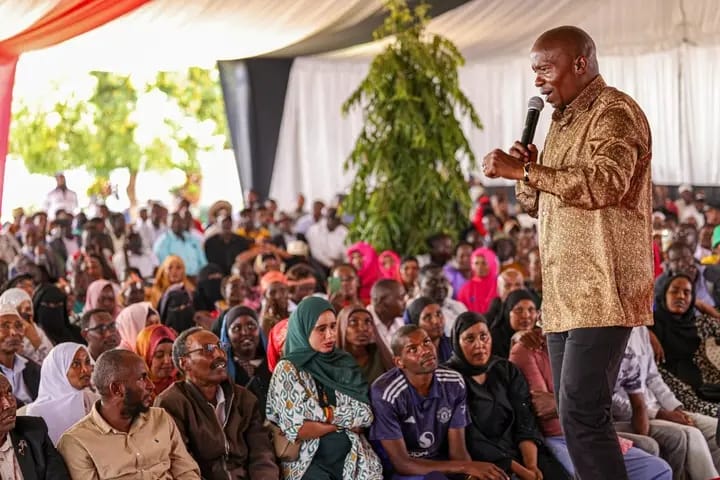
In late August 2025, DP Kindiki made a multi‑county tour of the North Eastern region, centering on empowerment forums and oversight of ongoing development projects. On 23 August, he addressed constituents at the Mandera East Constituency Economic Empowerment event in Elwak town, Mandera County, where he reassured the people that the Kenya Kwanza administration was moving with urgency to uplift regions long neglected. Kindiki highlighted a wide range of development initiatives: affordable housing across North Eastern counties, hybrid electricity plants under construction in Elwak, Eldas, Merti, and Habaswein, and a large solar power project in Garissa. He further spotlighted major infrastructure works, especially the 750‑kilometre Isiolo–Modogashe–Wajir–Tarbaj–Kotulo–Rhamu–Mandera road, valued at about KSh 100 billion, and the Lamu–Ijara–Garissa–Isiolo road, being built to open up trade and access.
During the same tour, Kindiki also spoke in Wajir East at the Ohahey Grounds, where he stressed that Northeastern Kenya will be treated equally in development efforts, and announced the scrapping of discriminatory vetting in the acquisition of national IDs — a step that many residents had long demanded.
The following day (or very close to that time), Kindiki presided over an Economic Empowerment forum in Modogashe, Garissa County (Lagdera Constituency), where he commended local leaders, including Eldas MP Adan Keynan and Dadaab MP Farah Maalim, for their collaboration with the central government. Thousands of households are slated for electricity connections under a “last‑mile connectivity” programme; multiple markets are under construction; and large housing, energy, and road works are underway throughout the region.
Earlier, in May 2025, Kindiki had confirmed that the construction of the Isiolo‑Mandera highway had begun. He visited various sections of the route, which had been divided into 11 sections and awarded to seven contractors. He emphasized the dual aims of the project: not only to physically connect remote parts of Northern Kenya for economic reasons — easing transport, trade, mobility — but also to think of it strategically in terms of security, by improving access and oversight in areas previously difficult to reach.
Also in September 2025, specifically on 18 September, Kindiki led government leaders through Garissa, Wajir, and Mandera counties in what was described as an empowerment fundraiser but also a platform to reassure citizens about the government’s commitment to “equity in development.” In Modogashe town, Garissa County, Kindiki reiterated that the Kenya Kwanza government was delivering on its promise that all regions should enjoy development without discrimination. He again referenced the removal of the vetting requirements for identity documents, and restated that large infrastructure projects — including the 750‑km road between Isiolo and Mandera — were being executed, and would be completed within the next two years.
Through the tour, Kindiki’s messaging was consistent: that North Eastern Kenya, long marginalized by previous administrations, was now receiving focused attention — in roads, markets, energy, housing, citizenship rights, and other public services. The tour also underscored a strategy of engaging locals and local leaders, building collaboration, and delivering visible projects. The actual execution — the roads being built, the electricity being connected, the housing constructed — provides evidence that the rhetoric is being matched with action.

